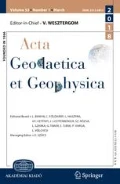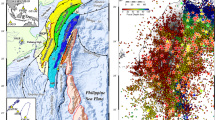Abstract
The geocentric datum of Turkish CORS Network (TUSAGA-Aktif) is a semi-kinematic datum realized with respect to the International Terrestrial Reference Frame (ITRF 96) at the reference epoch of 1 January 2005 (2005.00). This realization was maintained by ITRF no net rotation (NNR) velocities of CORS stations. Up-to-date ITRF NNR velocities were determined by General Command of Mapping in Turkey using 7 years of CORS stations data from 2008 to 2015. In accordance with Turkish surveying regulation, there are two types of coordinate computation of the control points performed with Global Navigation Satellite System relative positioning technique based on the datum. Coordinates of the first-order and the second-order control points are computed in semi-kinematic datum, whereas the third-order control points are computed in static datum. Generally, CORS stations of TUSAGA-Aktif are used as fiducial stations for coordinate computation of these control points. In this study, baseline deformation effect of static datum on the three-dimensional position of the points are investigated. 20 CORS stations within TUSAGA-Aktif were chosen to simulate the rover and the fiducial stations. The results show that relative displacement from the reference epoch (2005.00) between the rover-fiducial stations at the measurement time and the positioning error of the rover station are in a good agreement. The differences are in the order of mm to cm level. The results also show that when more than one fiducial station used in static datum processing, mean relative displacement between the rover-fiducial stations at the measurement time and the positioning error of the rover are also in a good agreement. The results emphasized that, velocities of the fiducial stations should be known by the users for conducting static datum processing with minimum baseline deformation as much as possible.




Similar content being viewed by others
References
Altamimi Z, Collilieux X, Métivier L (2011) ITRF2008: an improved solution of the International Terrestrial Reference Frame. J Geod 85(8):457–473. https://doi.org/10.1007/s00190-011-0444-4
Blewitt G (1990) An automatic editing algorithm for GPS data. Geophys Res Lett 17(3):199–202
Blick G, Crook C, Grant D, Beavan J (2006) Implementation of a semi-dynamic datum for New Zealand. A window on the future of geodesy, international association of geodesy symposia, 2005, vol 128, pp 38–43. IUGG General Assembly, Sapporo, 30 June–11 July 2003
Chang C, Tseng L (1998) A geocentric reference system in Taiwan. In: Surv Rev Department of Surveying and Mapping Engineering Chung Cheng Institute of Technology, Taiwan, ROC
Dawson J, Woods A (2010) ITRF to GDA94 coordinate transformations. J Appl Geod 4(4):189–199
Ge M, Gendt G, Rothacher MA, Shi C, Liu J (2008) Resolution of GPS carrier-phase ambiguities in precise point positioning (PPP) with daily observations. J Geodesy 82(7):389–399
Henton J, Craymer M, Ferland R, Dragert H, Mazzotti S, Forbes D (2006) Crustal motion and deformation monitoring of the Canadian landmass. Geomatica 60(2):173–191
Herring TA, King RW, Floyd MA, McClusky SC (2015) Introduction to GAMIT/GLOBK release 10.6. Department of Earth, Atmospheric, and Planetary Sciences, Massachusetts Institute of Technology, Cambridge, MA
Lagler K, Schindelegger M, Böhm J, Krásná H, Nilsson T (2013) GPT2: empirical slant delay model for radio space geodetic techniques. Geophys Res Lett 40(6):1069–1073
Özdemir S (2016) TUSAGA ve TUSAGA-Aktif İstasyonlarının Hassas Koordinat ve Hızlarının Hesaplanması Üzerine. Harita Dergisi, 155. https://www.hgk.msb.gov.tr/images/dergi/makaleler/263b1243ca2dbeb.pdf. Accessed Jan 2018
Pearson C, McCaffrey R, Elliott J, Snay R (2010) HTDP 3.0: software for coping with the coordinate changes associated with crustal motion. J Surv Eng 136:80
Stanaway R (2004) Implementation of a dynamic geodetic datum in Papua New Guinea: a case study. M.Phil. Thesis, The Australian National University
Stanaway R, Roberts C, Blick G (2011) Realisation of a Geodetic Datum Using a Gridded Absolute Deformation Model (ADM). In: Proceedings of the IAG General Assembly, Melbourne, Australia, June 28–July 2, 2011
Tanaka Y, Saita H, Sugawara J, Iwata K, Toyoda T, Hirai H, Kawaguchi T, Matsuzaka S, Hatanaka Y, Tobita M, Kuroishi Y, Imakiire T (2007) Efficient maintenance of the Japanese Geodetic Datum 2000 using crustal deformation models—PatchJGD & semi-dynamic datum. Bul Geog Surv Inst 54
Uzel T, Eren K, Dindar AA (2010) Monitoring plate tectonics and subsidence in Turkey by CORS-TR and InSAR. In: FIG Congress 2010, Sydney, Australia
Acknowledgements
The author would like to express their gratitude to Massachusetts Institute of Technology (MIT) for providing GAMIT/GLOBK scientific software. The author thank to Soner Özdemir at General Command of Mapping for providing the coordinate time series of AKSR-CIHA-KAMN-POZA stations for this paper. Coordinate time series of ADAN station were taken from the proceeding of “TUSAGA ve TUSAGA-Aktif Veri Analizleri: Stratejiler, Bulgular ve Öneriler” in Türkiye Ulusal Jeodezi Komisyonu (TUJK) Bilimsel Toplantısı-Sabit GNSS İstasyonları Uygulamaları-2017.
Author information
Authors and Affiliations
Corresponding author
Rights and permissions
About this article
Cite this article
Öğütcü, S. Deformation of static datum: Turkish CORS network (TUSAGA-Aktif) is considered. Acta Geod Geophys 53, 543–553 (2018). https://doi.org/10.1007/s40328-018-0223-2
Received:
Accepted:
Published:
Issue Date:
DOI: https://doi.org/10.1007/s40328-018-0223-2




